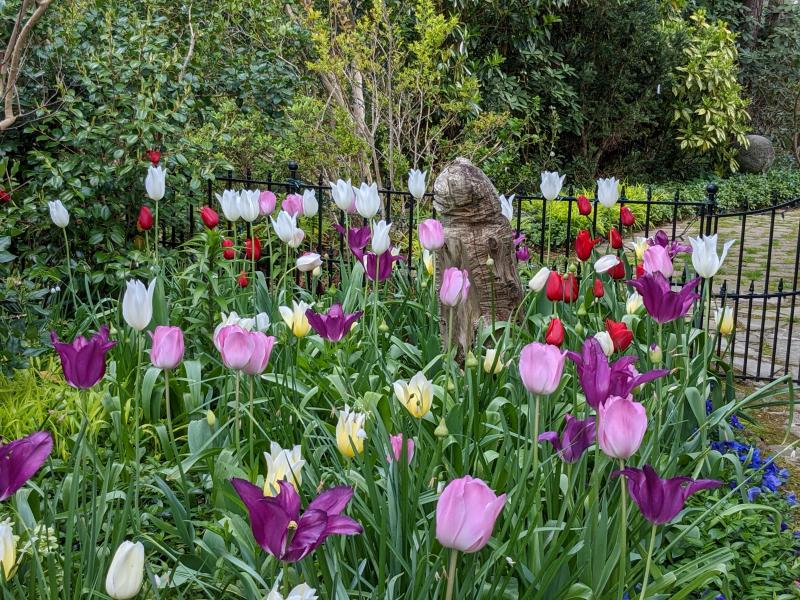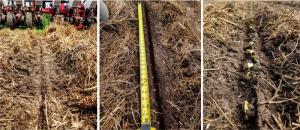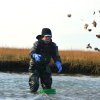Mill Pond Garden will hold an open garden day from 10 to 11:30 a.m., Sunday, May 15. Visitors can observe how Mill Pond Garden practices the five tenets of carbon farming in large, undisturbed garden beds with wonderfully productive and beautiful results.
For tickets, go to millpondgarden.com. The garden will also feature abundant flowering rhododendrons, roses, azaleas, clematis, wisteria, weigela, iris, daylilies and more, with lots of glorious color.
Carbon farming is an old practice being revived in recent times across the country on big and little farms, and in private gardens. The practice is gaining momentum as something individuals can do to help stop climate change by restoring carbon into the living soil.
Plants take carbon as carbon dioxide out of the air by photosynthesis and make it into sugars – the carbohydrates in sap that flow down to the plants’ roots, feeding the microbiome of beneficial soil bacteria and fungi which stores and shares the carbon with a multitude of living creatures in the soil.
The soil itself becomes a carbon storage bank. Looking at a handful of black earth from the forest floor, or healthy farm or garden soil, the blackness is from the carbon compounds, called humates. This carbon makes the soil rich, beneficial to many tiny living creatures, alive and sticky, causing granularization of the soil, and creating air and water spaces around the soil particles. This rich root zone of topsoil is called the rhizosphere – literally the root zone.
Modern tillage and chemical-use farming practices destroy soil and the living biome, which over time decreases productivity, quantity of yield, soil aeration and resistance to diseases. Farmers have found these bad practices gradually reduce income, and increase costs and work. Soil loses moisture retention and aeration capability, crop plant health declines, and farming requires even more pesticides and fertilizer, in an endless, expensive cycle of loss.
The five tenets of carbon farming are: limited soil disturbance, soil armor, plant diversity, living roots and integrated animals.
Limited soil disturbance means no tilling. Delaware has a large amount of modern no-till farming. Instead of plowing or discing fields, the old cut-off crop and debris are left in place to shelter and fed the soil biome, and seeds are planted in tiny slits or perforations through this soil ‘armor’ layer.
Plant diversity means plants do better with neighbors of different species, which used to be done by Native Americans Indians, who grew corn crops mixed in with beans, squash, sorghum, peppers, tomatoes, potatoes, lettuces, edible weeds and herbs for bigger harvests of all of them. Mixed crops discourage pests and diseases. Home gardeners can do less work and get better results in not only vegetable patches but for all ornamental plant beds and lawns as well.
Jen Nelson, Delaware Association of Conservation Districts executive director, said, “One key soil health principle is ‘do not disturb.’ This campaign is a fun way to remind and engage farmers about the important relationship between tillage and soil health.” Practicing no-till is preserving the soil armor tenet of carbon farming by keeping carbon in the soil.
Delaware farmer Blaine Hitchens said, “No-till is maintaining crop residue throughout the year and planting directly into it.” Hitchens is using this practice on his cropland near Laurel to improve soil health and reduce his input costs.
According to the Sussex Soil Conservation No-Till program, major benefits of the practice include decreased erosion, reduced input cost, improved soil health, reduced soil compaction and reduced evaporation.
Another tenet of carbon farming and gardening is ‘living roots,’ meaning leaving all old plant roots in the ground, even after the tops are cut off for harvest if growing crops. This leaves the microbiome undisturbed and functioning.
The fifth tenet of ‘integrated animals’ means animals and their wastes end up in the soil, instead of fertilizer, rounding out the needs of feeding the plants. Animals means all the tiny animals of the biome and rhizosphere up to and including worms and their castings, fallen dead animals like birds and mice, and especially for farmers and gardeners, manure from horses, cows or chickens spread on top or dropped by the animals which are allowed to feed on pastures.
Following nature on the land holistically is what makes all the parts of nature thrive their best, a perfectly renewable and sustainable way to go, the way humans must go to survive.
A summary for home gardeners could be included in these practices: Fertilize beds with animal manures or vegetative compost and encourage all living things to live on the garden. Feed worms and birds and beneficial creatures of many kinds by leaving leaves chopped and mowed into the laws and or beds. Leave old vegetable garden plant roots in place, and in spring add new ones in narrow slits for seeds or starts to be dropped in. Make ornamental plant beds large and diverse with trees, shrubs, perennials, ground covers all mixed in together. Except on lawns, leave all the fallen leaves and dead perennial plant tops in place every fall and winter. They can be chopped down or removed just before spring. Stop using commercial chemical fertilizers (all salts), mulch (high in heavy metal minerals), pesticides and herbicides, which are toxic to the biome. The only mulches not toxic to the biome are pine bark, pine needles, straw or cardboard. The best mulch is compost of leaves and other such organic material, or preferably ground covers. Fill in with plants.
If gardeners and even more farmers take up carbon farming, a lot of carbon dioxide can be taken out of the atmosphere and put back into the soil where it becomes a big part of thriving life, making a happier, more stable planetary climate. Big results can come from the small personal actions of the many.

























































